
Sean N
-
Posts
1,497 -
Joined
-
Last visited
-
Days Won
4
Content Type
Profiles
Forums
Gallery
Blogs
Events
Articles
Store
Downloads
Posts posted by Sean N
-
-
I remember on at least two occasions whilst working at the RAFM we had a chap come in looking for his old squadron badge which just so happened to be 633 sqn.
Thought there never was a real 633 squadron? Or are you suggesting the old chap wasn't entirely compos mentis?
-
my 1940 CS8 has a tin foot well, wooden planks up to it then thin tin with the well inside it.
[ATTACH=CONFIG]122228[/ATTACH]
Jules, I assume you plan to repair that frilly front mud wing? There is a slight risk of getting pulled for dangerous bodywork with it like that.
The CS8 aero screens had a little rubber bumber rest on the cowl . I found these on my 1939 CS8This rubber buffer looks to be a fairly standard size and shape. You might get replacements from one of the truck coachbuilding supplies places such as Albert Jagger, or one of the places that does vintage vehicle body rubber parts.
Edit - in fact, Albert Jagger 2023/002 is not far off, though a little shorter and wider.
BTW I noticed the front axle wheel track or width is quite a bit wider that the rear axle track . I wonder why the designers or the WD did that ?This seems to be quite common particularly on 4wd vehicles. The Austin K9 is significantly different - a good few inches at least. I once thought it might be to do with the driven front axle but it happens on 2wd vehicles as well, and anyway that doesn't explain it as the axle tubes and half shafts are different in any case.
It also occurs to me it might be that the rear track is narrowed deliberately (rather than the front widened) so that drop sides can drop fully without striking wheel or wheelarch while keeping the body within the overall width, but that's just a guess (and in fact I'm not sure is true for K9s, which are very wide at the front)
Alternatively it might be an attempt to make each wheel run in its own tracks to improve grip (another guess)?
Often there is an offset on the wheel nave plate so that the wheel can be fitted opposite ways round front and rear which goes some way towards evening out the track.
-
Slightly confused here ... how can even VOSA stipulate the use of such components on vehicles that ceased production before the marking was introduced.Even when pre 1960's vehicles were subject to MOT there were umpteen exemptions, simply because things like seat belts never existed when the vehicle was designed and built, and cannot be retrofitted to current standards.
Neil, what Tony said. Sorry, I probably sowed confusion because my initial reply to Tony was in general terms, not specifically on the E marking question - and in hindsight I probably misunderstood what he was saying.
For the sake of clarity and speaking generally an MoT exempt vehicle must be kept in a roadworthy condition which normally means it has to comply with the regulations that were in force at the time the vehicle was built.
I'll get my coat.
-
As pre 1960 vehicles in UK are exempt MOT, what can be said ' It lights up'?
Tony, MoT exempt not Construction & Use exempt. You are still under an obligation to keep an MoT exempt vehicle roadworthy, you just don't have to get it tested.
-
Sean thanks for the info...
Hi Robin, yes, I know where Wainwright and BATUS are, having been in Calgary a few years ago among other factors.
What surprised me was that west though AB is, it's still some considerable distance to Vancouver (1200km?), and shipping there puts you in the north Pacific which means North West Passage (not open in the '80s), down to Panama or right round the world via Suez.
It seemed a lot more direct despite Saskatchewan, Manitoba and Ontario to put things on a train, take them to the east coast ports and ship from there straight across the Atlantic or vice-versa - your comment about Montreal seems to confirm that.
Having said that, I suppose varying competitiveness of routes and shippers, availability of space on ships, ice and space on the many ships to and from Asia would all play a part.
-
There was a thread here some time ago in which someone suggested JeepParts Light Olive Drab is as near as makes no difference to Khaki Green. I don't know if it's a standard L.O.D. or their own colour though.
-
Yes it is, Ian
-
I came away from the company's yard
with a whole van full of Stolly and two good load bay doors on the roof
Excellent.
-
I'm sure at the same time he said it was a stolley he also said which film it was built for. It may have been one of the Alien films.
Ah, OK. So perhaps chopped about long before this programme was dreamed of then.
What I saw of the cab interior said Mk II to me - spent enough time behind the dash of one but I could be wrong :-) And it certainly looked and sounded OK whilst driving/ Agreed about the bang though - probably more propane or fuel/air mix to make a fireball than actual bang stuff :-)Not saying it wasn't a MkII - I only saw a short clip on YouTube and couldn't tell. And they all look and sound OK on camera! Maybe irrelevant if Chris' comment is right though.
When I was supplying stuff to TV to be blown up they used to do exactly that, lots of fuel to make a big fireball, lots of light stuff to make convincing debris / shrapnel but very little actual explosive. The stuff used to come back pretty charred and not exactly pretty but without any real mechanical damage.
Incidentally, Neil, did you see the Artists Rifles silver bowl on Antiques Roadshow the other day?
-
Robin, guesswork only but the string top left looks like the asset code. The block below it starting Cl. 1 - Class 1 repair and date etc? The string starting FSO appears to be associated with Vancouver, so part of the same shipping (or whatever) details?
Is BATUS stuff (which I assume it is) really shipped via Vancouver? Seems like the long way round!
-
Last year, when this programme was probably made, there were a fair few Stalwarts for sale. Most were Mk1s, most were in poor condition or had significant major faults. TV can make a very average vehicle look a million dollars with a bit of slap. It doesn't necessarily follow that a good vehicle was wasted.
I can't speak to what actually happened, but my guess is it's likely a lot of parts were stripped out in the conversion, a lot more before it was blown up, and the bang probably rigged to look very spectacular using as little actual explosive as possible.
-
Research into pedal effort and line pressures shows a huge variation; for example, pedal efforts as low as 30 lb and as high as 500 lb. However my understanding is that typical line pressures are in the range of 800 to 2000 psi depending on system and pedal pressure, and typical design pedal pressures are in the 20 - 120 lb range for an assisted system (maybe at the higher end for trucks).
As Richard says, on an assisted system you are likely to be reliant on the servo to attain full line pressure, and if you are measuring output pressure at the master cylinder, fluid is not bypassing the master cylinder pressure seals and you have no trapped air in your test set up it's difficult to see what could be wrong hydraulically; so if your pressure is low you are looking at a mechanical fault with linkage, servo or master cylinder.
Hydraulic pressure must be equal throughout the system, so if you are measuring line pressure by tee-ing into the system at a joint (and therefore testing the whole system pressure) low pressure might be due to a leak or failing seal anywhere in the system, so your test may not be very helpful unless you can selectively exclude different parts of the system.
You haven't mentioned what the actual problems with the brakes are - is this more of a point of interest?
-
Ian, why split it all up, or are these extra bits over and above the truck under restoration?
-
Chris, I guess you've already seen this web page which has some detail on the technical differences, some of which will be visible:
http://olive-drab.com/idphoto/id_photos_ward_lafrance.php
Possible Mike Gillman might be able to shed more light if he sees this.
-
Welcome. Something that always intrigues me is why US heavy truck manufacturers stuck with chain drive long after makers outside the US had abandoned it. Any ideas?
-
Hi Sean,
When I mentioned Firefox it was because someone else said they were using it and could not see the pics, so I suggested Firefox could be the problem, I am on the bog standard IE.
Indeed, and that's an entirely reasonable assumption, no criticism intended - I just thought I'd dig a bit further.
It's not the first time I've noticed you could see images others can't so it may well be your super mod status.
Anyway, I at least can see them on your post.
-
That ST66 looks relatively close if you want to keep an original look & feel. Go 10.00 x 20 and you wouldn't have the spare wheel size issue mentioned, though the gearing will be a touch lower. TT505 looks more like an earthmover tyre.
-
I don't think it is. I've tried in two different versions of Firefox and in Edge and they're not visible. I don't have Internet Exploder so can't try it.
Viewing the page source code in Firefox shows the URLs of the images; however searching for them or attempting to go direct to the album brings up the message that the album is not valid or is not publicly accessible.
The album also doesn't show on bcoycqms' profile, although the coding seems to point to an HMVF album.
I wonder if the album they're in is set to private and Richard can see it because of his super mod status, or something like that?
-
I think I have seen this one for sale online a couple of times now; http://www.ebay.co.uk/itm/Scammell-Pioneer-/122276221591?hash=item1c783b1297:g:KR4AAOSwNyFWfAV~
At £23k, without up to date photos and needing batteries, repairs to the cab and paintwork I suspect you'll be seeing it for sale quite a lot more!
-
And last and perhaps not least I also managed to acquire on of the seemingly uber-rare 1 gallon oil cans for the rear lockerI'd have to check, but I'm sure I have a quantity of those!I presume we are talking about the little can that should live in this rack on my Tanker, if you do have a spare one Sean could you put my name on it, please. Many beer tokens would be available.
Just had a look at the workshop. I have cans in several sizes, including the square oil can and the more rectangular one. I had mentioned them before, in the 'What's Sean got now?' topic.
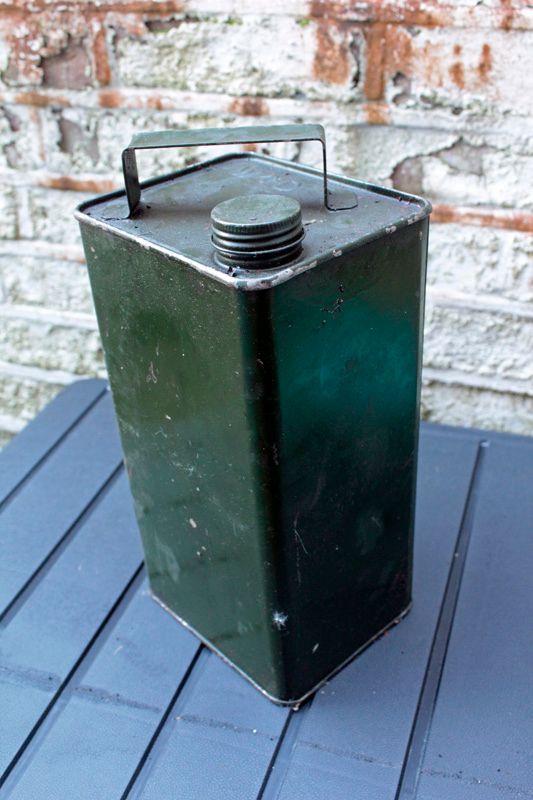
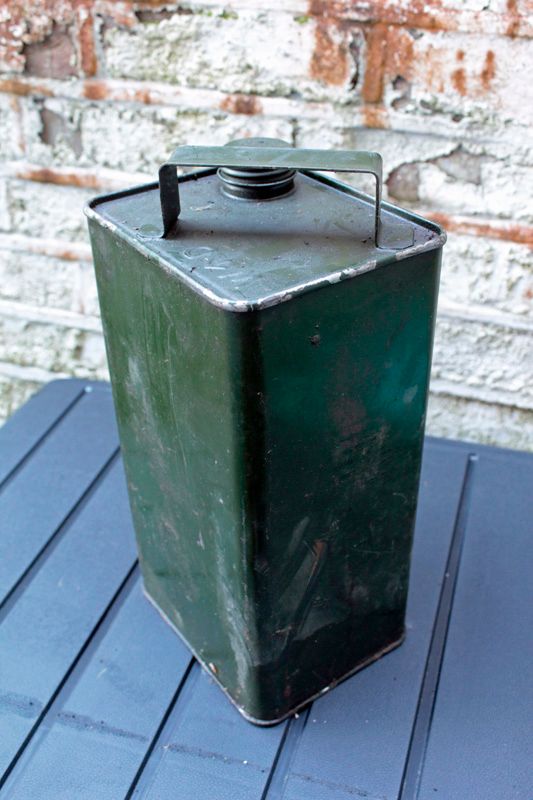
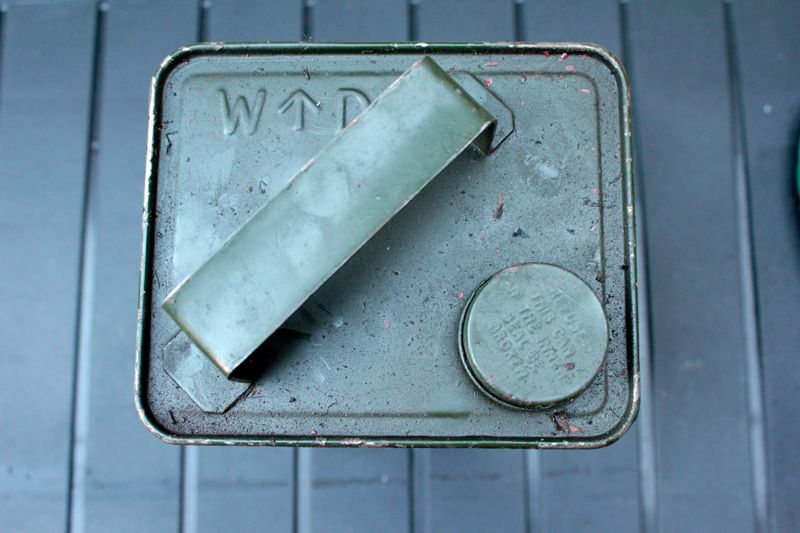
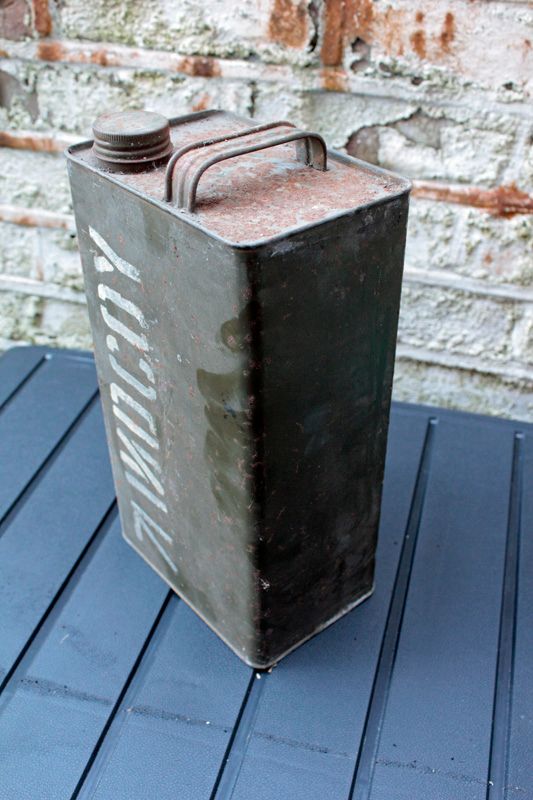
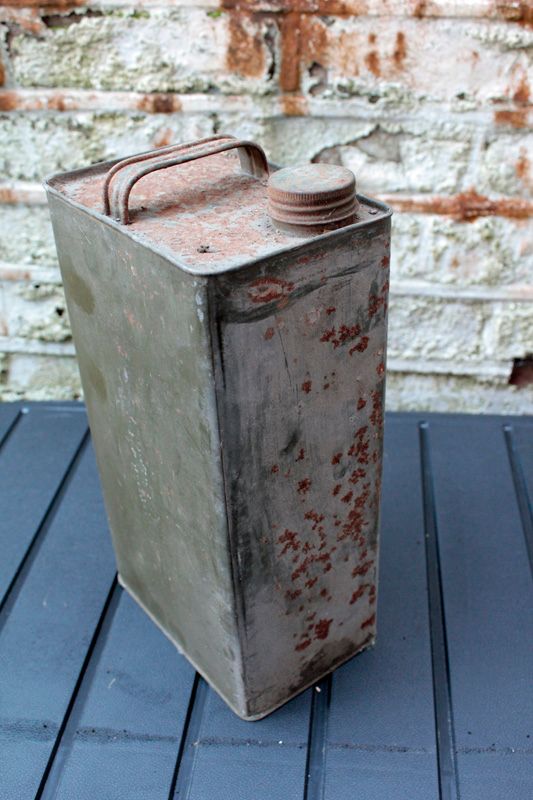
Both are around 11 3/8" (288 mm) high plus handle and lid. The squarer ones are about 5" x 6" square and the narrower ones are 4 3/8" x 6 1/2" square.
None are mint, but all are pretty good and all have 1950s dates. Most of the square ones are embossed WD & broad arrow.
Also have some small one quart cans as you can see from the last photo.
-
Is the dust really carbon, or carbonised friction material from the clutch driven plate? If the latter, and it's older, be careful of asbestos.
Given it's a Rover V8 and parts are easily obtained I'd be inclined just to replace the flywheel with a good second-hand one. It might skim, but once they're cooked like that they're not all that easy to bring back and the chances are the cracks run quite deep, even assuming there's no distortion.
It sounds as though the situation with the release bearing and clips was precipitated by the clutch failure not the other way round.
-
From memory I recall the rear brake figures were much higher than Hutch's readings. Somewhere in the 1200-1300kgf sort of area (11.76-12.74kN). Biggest difference is mine all locked out as well.
That makes more sense. Apart from anything else, Hutch has two readings in the 10 - 12 kN range, which implies the rest are low and efforts of that order at least should be achievable all round.
Having said that, another quick calculation says that a true pass should be about 15 kN all round...
The brick would be stood upright on the cab floor, the vehicle would then be driven at ( I think) 10mph and an emergency stop performed. If the vehicle stopped in a straight line and the brick toppled over the brakes were deemed good enough.Upright on end or upright on one long side?
-
If I use Hutch's figures and the unladen weight of a Militant, I get 43% which would be a comfortable pass.
Well, a pass. Given a 40% minimum and a reasonable expectation of 66%, I wouldn't say 43% was comfortable; under 25% considerably less so.
As for being a Militant expert, I'm not sure about that oneWell, you, Neil and Richard have considerably more experience of the dark and oily bits of Militants than I, so had you said those were typical figures I'd have deferred; but they don't seem adequate to me.
-
Indeed. as Richard suggests, inspecting everything means inspecting everything. I know it's heavy work, but whip the drums off and have a look.


633 Squadron
in MV Chatter
Posted
Have David McCallum / Ilya Kuryakin become he who must not be named?